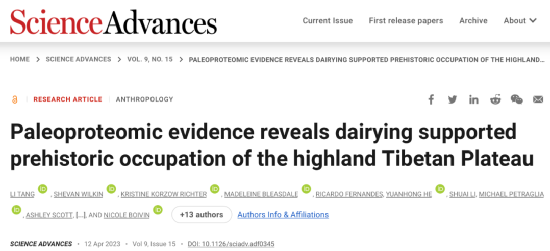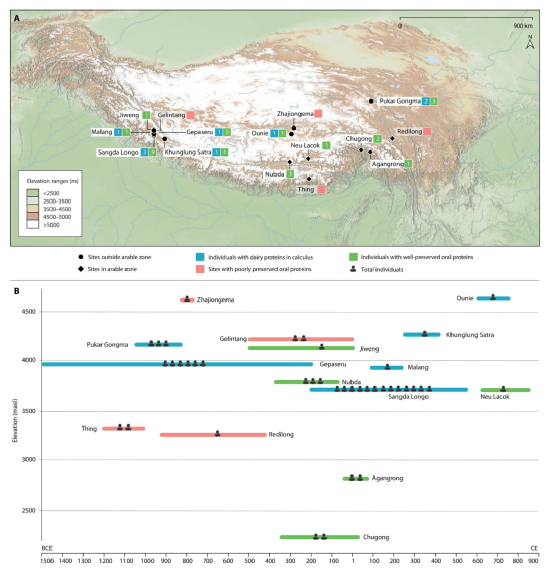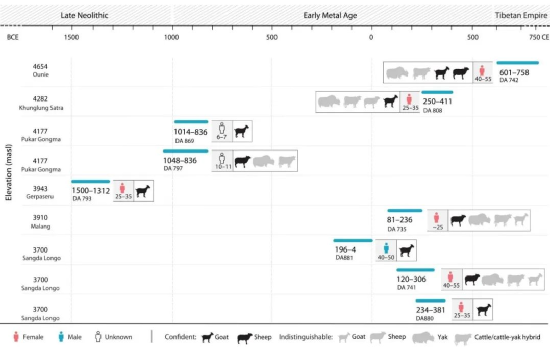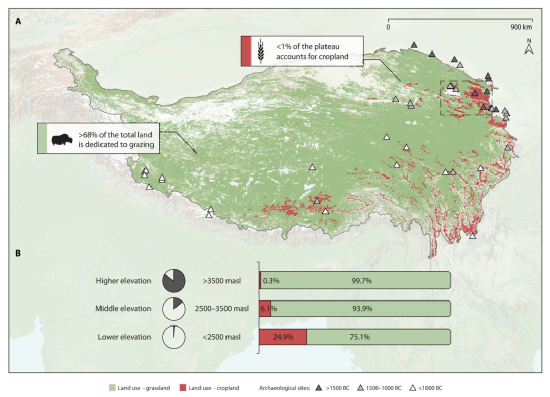Center for Archaeological Science, Sichuan University, in collaboration with domestic and international teams, published an article revealing the history of dairy consumption among ancient populations on the Tibetan Plateau.

Recently, a collaborative research project by Prof. Lvhongliang's team from the Center for Archaeological Science, Sichuan University, the Institute of Cultural Relics Protection of Tibet Autonomous Region, and the Max Planck Institute for the Science of Human History in Germany has yielded new results. The findings, titled 'Palaeoproteomic evidence reveals dairying supported prehistoric occupation of the highland Tibetan Plateau,' were published in the international multidisciplinary scientific journal Science Advances. Prof. Lvhongliang from the Center for Archaeological Science, Sichuan University, is a co-corresponding author of the paper, and Tangli, a master's graduate from Sichuan University under the guidance of Prof. Lvhongliang, is the first author. This research was funded by the National Key Research and Development Program and the National Social Science Fund Major Project undertaken by our university.

Figure 1. Geographical and temporal distribution of dental calculus samples in this study
This study is the first to apply paleoproteomics to the study of prehistoric human diets on the Tibetan Plateau. Researchers extracted and analyzed protein information from dental calculus samples of 40 human skeletons unearthed from 15 archaeological sites on the Tibetan Plateau, finding that the ancient people in the heart of the Tibetan Plateau began consuming dairy products at least 3500 years ago (Figure 1). The earliest evidence of milk protein was found in western Tibet, which is similar in age to the earliest cattle and sheep bones in the area, indicating that dairy products and domesticated animals may have been introduced to the high-altitude areas from the surrounding lowlands at the same time. Protein evidence in human dental calculus suggests that consuming dairy products was a powerful cultural adaptation, promoting the expansion of prehistoric people to the vast non-arable areas of the plateau, providing new perspectives for understanding high-altitude adaptation mechanisms, prehistoric human-environment relationships, and social development.
The Tibetan Plateau is known as the "Third Pole" and the "Roof of the World." High altitude, low temperature and oxygen, and fragile ecosystems make it one of the most harsh and uninhabitable regions in the world. Although genetic adaptation has made the people who have lived here for generations more physiologically adapted to the high-altitude environment, obtaining sufficient and sustainable food to maintain long-term settlement remains an extremely severe challenge. The contribution of highland barley and millet to the prehistoric human colonization of the Tibetan Plateau has been widely discussed, but our understanding of the contribution of pastoralism, especially dairy products, to the plateau's pillar economy remains unclear.
Tracing the history of ancient dairy farming is extremely difficult, as dairy products are usually difficult to preserve and are rarely found in archaeological sites. Although animal remains and pottery residue evidence are often used to explore prehistoric dairy farming, they usually only provide indirect evidence of human consumption of dairy products. Paleoproteomic studies explore important topics such as ancient human evolution and phylogeny, ancient subsistence and diet, and disease and health by extracting and analyzing the amino acid sequences of proteins in ancient remains. It can not only provide the most direct evidence of ancient people's consumption of dairy products, but also determine which animals the dairy products came from.

Figure 2. Gender, age of individuals consuming dairy products, and animal species information corresponding to milk proteins in their dental calculus
The study found that dairy products were a "national food" in the prehistoric plateau hinterland. Paleoproteomic evidence shows that diverse populations, including women and men, adults and children, elites and commoners, consumed dairy products (Figure 2). In addition, prehistoric herders attempted to use dairy products from a variety of animals. We found definitive goat's milk and sheep's milk, as well as suspected yak and cattle milk. We also found that early herders in western Tibet seemed to have a particular fondness for goat's milk. More interestingly, the study also observed a very distinct regional distribution pattern. All milk proteins come from the "pastoral areas" - western and north-central Tibet, while no dairy-related proteins have been found in the "agro-pastoral areas" - southern Tibet. Surprisingly, all individuals who consumed dairy products were found at sites above 3700 meters above sea level, with nearly half of the individuals from sites above 4000 meters, the highest being 4654 meters (Figure 2).

Figure 3. Distribution of agricultural and pastoral land use on the Tibetan Plateau (red is arable land, green is pastoral land, the dotted box on the map is the core research area of the "Highland Barley Hypothesis", and the triangles indicate the archaeological site ages and locations of domesticated cattle, sheep, and horse bones unearthed)
Paleoproteomic evidence suggests that dairy products played a crucial role in supporting the colonization of high-altitude areas of the Tibetan Plateau by prehistoric people. Agriculture is certainly important, but arable land accounts for only about 1% of the total area of the plateau, and nearly 70% of the land is too extreme for cultivation and can only be used as pasture (Figure 3). Animals such as cattle and sheep can convert high-mountain pasture resources into nutritious meat and milk resources. Sustainable, portable, and storable dairy products provided important food security for ancient people, promoting the expansion of prehistoric people on the Tibetan Plateau to vast non-arable grasslands.
Source锝淐enter for Archaeological Science, Sichuan University
